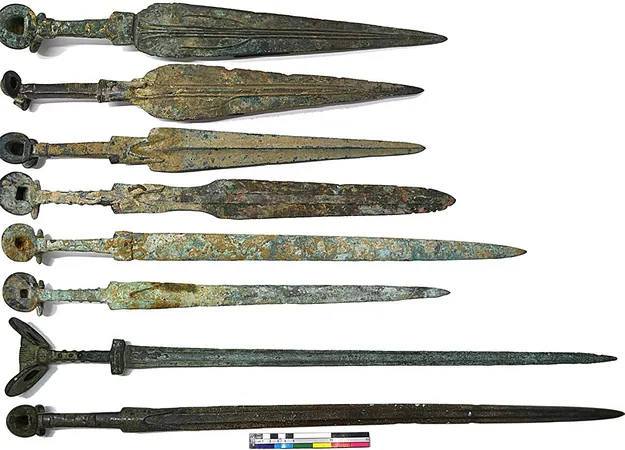
Groundbreaking Imaging Technology Exposes Forged Iron Age Iranian Swords – What Archaeologists Found Will Shock You!
2024-10-08
Author: Li
Groundbreaking Imaging Technology Exposes Forged Iron Age Iranian Swords
In an unprecedented investigation, advanced imaging techniques have unveiled that several confiscated Iron Age Iranian swords are not what they seem. Significant modern modifications have been detected, revealing that these ancient weapons were altered to inflate their value within the illicit antiquities market.
Understanding the craftsmanship behind Iron Age Iranian bladed weapons is vital for comprehending the sophisticated metalworking technologies that thrived in the ancient Near East. Disguises of imitation and forgery in such artifacts distort our ability to trace the progression of metallurgical advancements from around 3,000 years ago, complicating archaeological research.
Identifying these modern alterations is crucial not only for reconstructing ancient technological innovations, but it also plays a key role in exposing and combating the darker aspects of the illicit antiquities trade that threaten global heritage.
A Revolutionary Method: Neutron Tomography
A collaborative research effort led by experts from Cranfield University, the ISIS Neutron and Muon Source, and the British Museum employed neutron tomography for the first time on these ancient weapons. This cutting-edge imaging method allows researchers to delve into the internal structures of the swords, uncovering the use of contemporary materials such as glue and other tools that criminals employ to obscure their deceit from unsuspecting collectors.
The findings have been documented in the notable paper titled “Neutron Tomography Reveals Extensive Modern Modification in Iron Age Iranian Swords,” published in the Journal of Archaeological Science. Unlike conventional X-ray imaging, neutron tomography adeptly highlights organic materials, revealing the hidden glues and other alterations made by forgers.
Creating "Frankenstein's Monsters"
The focal point of this research was a group of swords recently intercepted by the UK Border Force, currently stored at the British Museum, awaiting repatriation to Iran. Approved by Iranian authorities, the study exposed how these swords had been tampered with; modern bronze blades were affixed in place of the original iron counterparts, crafting what is described as “pastiches.” This term refers to artifacts created from authentic, albeit fragmented, ancient components, piecing them together in a misleading attempt to enhance market value.
Startling Discoveries of Modern Tampering
Utilizing neutron imaging at the ISIS Muon and Neutron Source, the researchers discovered several alterations forged into the swords, including contemporary drill holes that were easily identifiable due to their uniform shapes and sizes. In a particularly bizarre encounter, one sword even harbored a fragment of a modern drill bit cleverly embedded within it.
The Broader Impact on Heritage Crime
The implications of this research extend beyond just a few forged artifacts; it sheds light on the broader complications of heritage crime and the ongoing authenticity crisis affecting museum collections around the globe.
Alex Rodzinka, a Ph.D. student in archaeology on this project, highlighted the significance of bi-metallic objects in understanding the historical shift from bronze to iron technology, noting that illicit modifications severely hinder such research ambitions.
“Neutron analyses have been essential. If a bronze-bladed sword features iron in the hilt, it could very likely be a pastiche,” stated Anna Fedrigo, an imaging scientist involved in the study.
Nathaniel Erb-Satullo, a Senior Lecturer in Archaeological Science at Cranfield University, emphasized Iran's pivotal role in metallurgical innovation over centuries. He noted that using advanced imaging methods to distinguish between ancient practices and modern forgeries is crucial to acknowledging and celebrating these rich traditions of metallurgy.
The collection of swords, part of a wider series of trafficked artifacts, is scheduled for a temporary exhibition at the British Museum before being returned to its rightful home in Iran. This groundbreaking research not only illuminates the intricate history of ancient craftsmanship but also serves as a critical warning against the perils lurking within the illicit antiquities market.




 Brasil (PT)
Brasil (PT)
 Canada (EN)
Canada (EN)
 Chile (ES)
Chile (ES)
 España (ES)
España (ES)
 France (FR)
France (FR)
 Hong Kong (EN)
Hong Kong (EN)
 Italia (IT)
Italia (IT)
 日本 (JA)
日本 (JA)
 Magyarország (HU)
Magyarország (HU)
 Norge (NO)
Norge (NO)
 Polska (PL)
Polska (PL)
 Schweiz (DE)
Schweiz (DE)
 Singapore (EN)
Singapore (EN)
 Sverige (SV)
Sverige (SV)
 Suomi (FI)
Suomi (FI)
 Türkiye (TR)
Türkiye (TR)